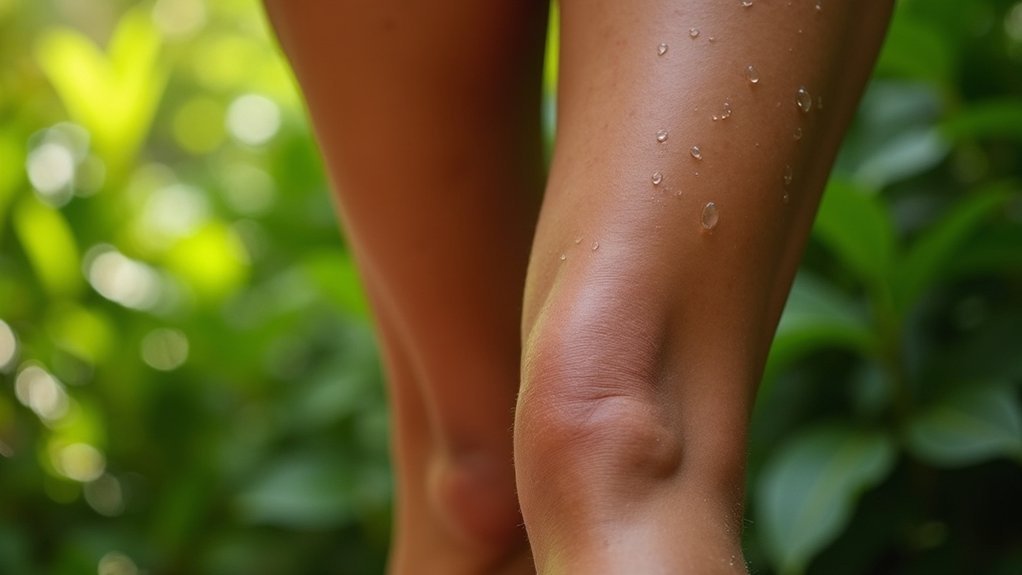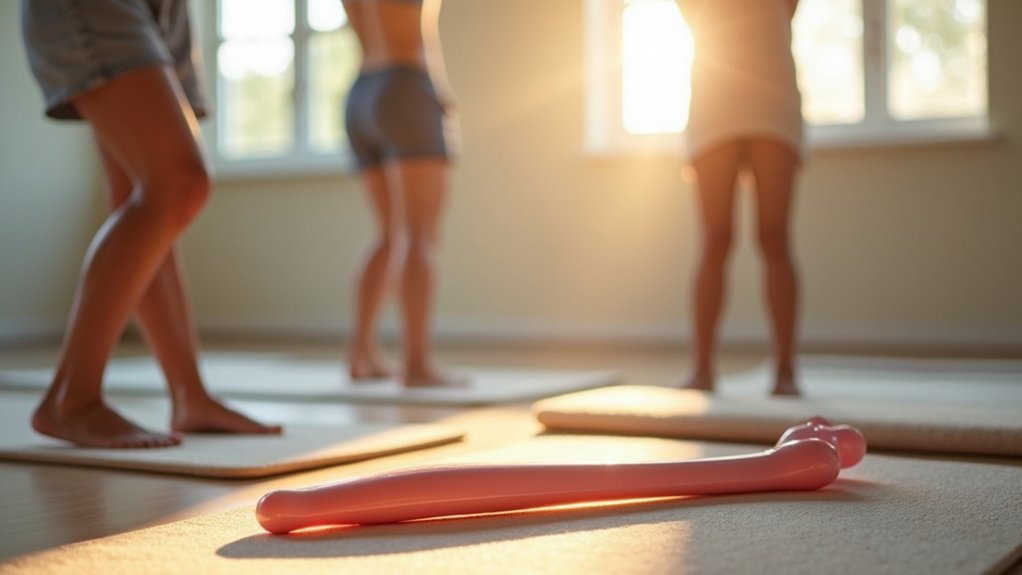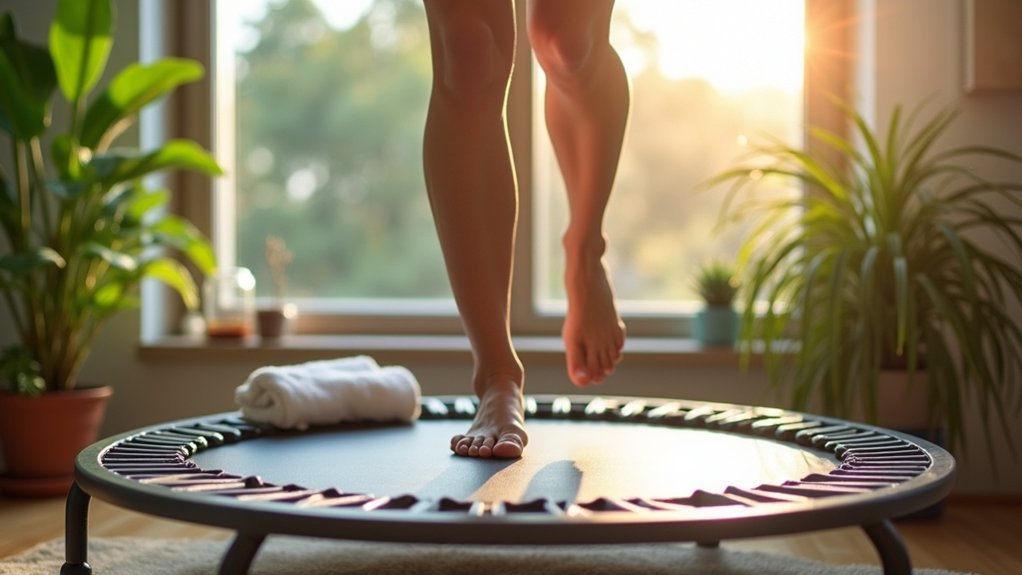Lymphatic exercise eliminates cellulite by addressing its root causes rather than just symptoms. When you bounce on a mini-trampoline, you’re activating one-way valves in your lymphatic vessels, increasing flow up to 15 times normal rates. This enhanced circulation flushes out trapped toxins and reduces fluid retention that worsens cellulite’s appearance. Just 10 minutes daily can greatly improve drainage in cellulite-prone areas. The transformation begins beneath the surface before visible changes emerge.
The Science Behind Cellulite Formation: Beyond Skin-Deep

While many dismiss cellulite as merely a cosmetic concern, its formation involves complex structural, hormonal, and physiological mechanisms that extend far beneath the skin’s surface.
Your skin’s architecture plays the primary role—women have vertical fibrous septa that create dimples when fat pushes against them, unlike men’s crisscross pattern that resists puckering.
The feminine skin blueprint, with its vertical scaffolding, inevitably yields to gravity’s dimpling effects—unlike the male’s resistant crosshatch design.
This structural difference explains why over 90% of women develop cellulite regardless of weight.
Your hormones further complicate matters, as estrogen weakens connective tissue while promoting fat storage in thighs and hips.
Impaired circulation and lymphatic drainage exacerbate the condition by increasing inflammation and fluid retention, leading to more visible dimpling.
Genetics also dictate your predisposition, affecting everything from fat distribution to skin thickness.
How Rebounding Activates Your Lymphatic System
Unlike your cardiovascular system with its powerful heart pump, your lymphatic system relies entirely on physical movement to circulate.
Rebounding offers a uniquely effective solution to stimulate this vital system. When you bounce on a mini-trampoline, the alternating weightlessness and increased gravitational pull creates a pumping effect that activates millions of one-way valves in your lymphatic vessels.
This gentle bouncing motion increases lymphatic flow up to 15 times normal rates, flushing toxins and reducing inflammation—key factors in cellulite formation.
The beauty of rebounding lies in its efficiency: just two minutes can greatly boost lymphatic circulation while being gentle on your joints. Designed for all fitness levels, this exercise is appropriate for beginners and advanced athletes alike, making it an accessible option for anyone looking to reduce cellulite. As you bounce, you’re also increasing oxygen circulation throughout your tissues, strengthening cells, and enhancing your body’s natural waste removal systems.
5 Ways Lymphatic Exercise Differs From Traditional Workouts

Traditional workouts often focus on building muscle or burning calories, whereas lymphatic exercise targets your body’s waste removal system in fundamentally different ways. Your approach to exercise requires complete rethinking when working with your lymphatic system. The gentle movements in lymphatic exercise stimulate the natural muscle contractions that help pump lymph fluid through your system.
| Aspect | Traditional Workouts | Lymphatic Exercise |
|---|---|---|
| Intensity | High-intensity, 70-90% max HR | Submaximal, 50-70% max HR |
| Movement | Linear, single-plane motions | Multiplanar, rhythmic pulsations |
| Duration | Short, intense intervals | Sustained 20-60 minute sessions |
| Focus | Muscle hypertrophy/calorie burn | Fluid clearance/waste removal |
| Progression | Progressive overload | Sequential, proximal-to-distal |
Unlike traditional workouts, lymphatic exercises incorporate diaphragmatic breathing, gentle rebounding motions, and full-body movement patterns. You’ll need consistent daily practice rather than intermittent training, with emphasis on recovery-oriented cool-downs to maximize drainage effects and collagen remodeling beneath your skin.
The Critical Connection Between Toxin Buildup and Cellulite
Your body’s fat cells often store toxins and metabolic waste products, leading to the dimpled appearance of cellulite when these cells bulge against connective tissue.
When your lymphatic system becomes sluggish, these toxins can’t efficiently exit your body, exacerbating the cellulite’s visibility.
Understanding this connection helps explain why lymphatic exercise works—it stimulates the pathways that flush these accumulated toxins from your subcutaneous tissue.
Toxin Accumulation Process
While the visible dimpling of cellulite frustrates many, understanding how toxins accumulate in your body reveals why lymphatic exercise offers an effective solution.
Your body collects toxins daily from processed foods, environmental pollutants, and stress. These toxins settle in your adipose tissue, where they trigger inflammation and break down collagen and elastin fibers that normally keep your skin smooth.
As toxins build up, they cause fluid retention that swells fat cells, forcing them to push through weakened connective tissue.
Poor lymphatic circulation compounds this problem, as your body’s natural detoxification system slows down. Without proper fluid movement, toxins remain trapped in tissues, further damaging skin structures.
This vicious cycle intensifies when lifestyle factors like dehydration, alcohol consumption, or smoking introduce additional toxins while simultaneously hindering removal pathways.
Metabolic Waste Pathways
Metabolic waste pathways form the hidden infrastructure that connects toxin accumulation to visible cellulite development. When your lymphatic system stagnates, metabolic byproducts become trapped in interstitial spaces, triggering a cascade of tissue-damaging effects.
These retained toxins—particularly free radicals—initiate localized inflammation and fibrotic changes that literally reshape your connective tissue.
The process intensifies through three primary mechanisms:
- Collagen degradation – Matrix metalloproteinases activated by toxins break down structural support, allowing fat to herniate.
- Hyaluronan buildup – Water-binding molecules accumulate, exacerbating edema and creating mechanical stress.
- Fibrosis development – Chronic inflammation stiffens connective tissue, creating tension that pulls skin downward.
This pathological cycle explains why improving lymphatic flow through targeted exercise delivers such dramatic improvements in cellulite appearance.
Real Results: What Clinical Evidence Shows About Rebounding

Scientific interest in rebounding has grown as researchers investigate its effects on cellulite reduction. Studies confirm that mini-trampoline exercises markedly enhance lymphatic drainage—a vital process for detoxifying the body and reducing cellulite appearance.
In a 12-week program, overweight women who participated in regular rebounding sessions showed notable health improvements that contributed to cellulite reduction. While extensive clinical evidence specifically targeting cellulite remains limited, the lymphatic benefits are well-documented.
You’ll typically see initial circulation improvements after just one session, but substantial cellulite reduction takes consistent effort—usually 12-20 weeks of regular practice. Rebounding effectively enhances the immune system through its ability to stimulate lymphatic flow by repeatedly opening and closing the valves in the lymphatic system.
Your results depend on several factors: session frequency, exercise intensity, diet quality, and baseline fitness level. For maximum effectiveness, combine your rebounding routine with balanced nutrition and maintain consistency.
Creating Your Daily 10-Minute Lymphatic Drainage Routine
A simple 10-minute daily routine can transform your lymphatic health and greatly reduce cellulite appearance. Start by creating a quiet space with your dry brush, lymphatic drainage paddles, and preferred massage oils.
Consistency is key—perform your routine at the same time each day, whether it’s morning to energize or evening to relax.
Your routine should include:
- Gentle, upward strokes moving toward lymph nodes using light pressure
- Focus on cellulite-prone areas like thighs and buttocks with circular motions
- Post-drainage hydration to help flush toxins from your system
Remember to always begin your massage session by working on the lymph node areas like your neck, armpits, and groin before addressing the cellulite-prone regions.
Track your progress through photos and skin texture changes.
Combine your drainage practice with short walks or rebounding exercises for enhanced results.
Common Rebounding Mistakes That Hinder Cellulite Reduction
Most rebounding enthusiasts make vital errors that greatly diminish their cellulite-reduction results.
Without proper core engagement and heel-to-toe bouncing, you’ll miss essential calf contractions that power lymphatic pumping. Standing with feet too close together limits muscle activation in cellulite-prone areas.
Engage your core and step heel-to-toe with feet properly spaced—your lymphatic system needs these movements to effectively battle cellulite.
Sporadic, short sessions won’t stimulate enough circulation for meaningful results. Regular rebounding of at least 10 minutes daily ensures your body receives the improved circulation benefits needed to combat cellulite effectively.
Static bouncing without varied movements (jumping jacks, jogging) fails to engage your entire lymphatic system.
Post-workout dehydration, high sodium intake, and alcohol consumption directly counteract your rebounding benefits by promoting fluid retention.
Meanwhile, overtraining elevates cortisol levels, actually increasing fat storage in problem areas.
Check your equipment too—improper trampoline tension reduces muscle activation efficiency, while cold environments constrict blood vessels, undermining your circulation goals.
Combining Rebounding With Other Proven Cellulite Treatments
Combining rebounding with massage therapy, topical treatments, and dietary changes creates a powerful synergistic approach to cellulite reduction.
You’ll maximize toxin elimination through enhanced lymphatic drainage when you pair rebounding with regular skin brushing and hydration strategies.
Studies show that patients who incorporate multiple treatment methods consistently achieve higher success rates than those relying on a single approach.
The long-term commitment to rebounding is essential for seeing significant cellulite reduction, as sustainable results require consistent practice rather than sporadic sessions.
Synergistic Treatment Approaches
While rebounding offers significant benefits for cellulite reduction, its effectiveness dramatically increases when integrated with complementary treatments.
Combining your lymphatic exercise routine with manual lymphatic drainage can improve circulation and enhance detoxification, though you should note that only about one-third of patients see significant improvement from drainage alone.
For ideal results, consider these evidence-based combinations:
- Pair rebounding with targeted strength exercises to improve collagen production and skin firmness while managing weight.
- Supplement your trampoline sessions with non-invasive treatments that enhance circulation and fluid removal.
- Create a holistic approach by alternating between rebounding days and manual lymphatic massage sessions.
These synergistic approaches address multiple cellulite factors simultaneously, from sluggish circulation to fluid retention, giving you more thorough results than any single treatment.
Enhanced Toxin Elimination
When your body struggles to eliminate toxins effectively, cellulite becomes more prominent as waste materials accumulate in fat cells. Rebounding accelerates your lymphatic flow rate, which is essential for removing these toxins and reducing fluid retention that contributes to dimpled skin appearance.
| Treatment Combination | Mechanism | Benefit |
|---|---|---|
| Rebounding + Massage | Enhances interstitial fluid turnover | Reduces inflammatory markers |
| Rebounding + Caffeine Creams | Improves microcirculation | Enhances lipolytic activity |
| Rebounding + Hydration | Potentiates lymphatic flow | Dilutes toxins for easier elimination |
| Rebounding + Foam Rolling | Breaks fibrotic tissue barriers | Releases trapped toxins |
| Rebounding + Infrared Sauna | Activates sweat-mediated excretion | Provides additional elimination pathway |
For ideal results, combine 10-30 minute rebounding sessions 2-3 times weekly with biweekly manual lymphatic drainage to accelerate toxin clearance and reduce cellulite’s visible effects.
Multi-Method Success Rates
Five distinct combination approaches have shown promising results in the battle against cellulite when rebounding is incorporated into a thorough treatment plan. The synergistic effect of multiple treatments addresses cellulite’s complex causes while improving adherence rates compared to single-method approaches.
- Manual drainage + rebounding enhances circulation with potential hip measurement reductions of 0.3-0.8 cm when combined consistently.
- Topical treatments absorb more effectively after rebounding increases blood flow, particularly with retinoid or caffeine-based formulations.
- RF/cavitation devices paired with rebounding accelerate metabolic waste clearance while minimizing required professional sessions.
While clinical evidence remains limited for combined approaches, patient-reported outcomes consistently favor multi-modal regimens, particularly those using rebounding as a cost-effective daily maintenance strategy between more intensive treatments.
What to Expect: Timeline for Visible Cellulite Improvement
Understanding realistic timelines for cellulite improvement can help you maintain motivation throughout your lymphatic exercise journey.
You’ll likely notice temporary improvements after your first few lymphatic massage sessions as water retention decreases. For significant reduction, commit to 6-8 treatment sessions.
Mid-term results emerge when you’re consistent. Clinical evidence shows regular manual lymph drainage can reduce leg perimeters by 6-10 cm. Track your progress by measuring or photographing affected areas.
Long-term success depends on your commitment to combining approaches: regular exercise improves circulation, proper diet supports lymphatic health, and maintenance treatments prevent regression.
Remember that individual results vary based on personal factors like weight and underlying conditions.
Don’t get discouraged if progress seems slow—visible changes typically require several weeks of dedicated practice.
Maintaining Results: Why Consistency Matters More Than Intensity
Although many people are tempted to approach cellulite reduction with intensive, sporadic treatments, consistency trumps intensity when maintaining lymphatic exercise results.
Your body needs 6-12 weeks to establish enhanced drainage routes, and sporadic sessions disrupt these adaptive changes.
Daily 10-15 minute gentle routines outperform weekly marathon sessions, preventing lymphatic backflow and stagnation while strengthening vessel efficiency over time.
To maximize your lymphatic exercise benefits:
- Incorporate daily dry brushing to sustain waste removal between sessions
- Drink 2-3 liters of water daily to maintain ideal lymph fluid viscosity
- Combine with an anti-inflammatory diet to reduce your lymphatic system’s workload
This consistent approach prevents recurring fluid retention and maintains the improved skin texture you’ve worked hard to achieve.
Frequently Asked Questions
Can Lymphatic Exercise Worsen Varicose Veins or Vascular Conditions?
Gentle lymphatic exercises typically don’t worsen varicose veins, but you’ll need proper technique. Avoid vigorous movements and high pressure that could increase venous strain. Always consult your healthcare provider for your specific condition.
How Does Hormonal Birth Control Affect Lymphatic Drainage and Cellulite Reduction?
Hormonal birth control can impair your lymphatic drainage by altering fluid dynamics and increasing estrogen dominance. This disrupts natural detoxification pathways, worsens fluid retention, and may intensify cellulite by promoting adipose congestion and inflammation.
Is Lymphatic Exercise Safe During Pregnancy?
Yes, lymphatic exercise is generally safe during pregnancy. You’ll need to avoid deep abdominal work, stay hydrated, and focus on extremities. Always get medical clearance first, especially if you have preexisting health conditions.
Can Lymphatic Exercise Help With Post-Liposuction Cellulite?
Yes, lymphatic exercise can help with post-liposuction cellulite by reducing fluid retention, decreasing inflammation, and improving circulation. You’ll see best results when combining it with compression garments as part of your recovery protocol.
Do Compression Garments Enhance or Hinder Lymphatic Exercise Benefits?
Compression garments enhance lymphatic exercise benefits when properly fitted. They improve circulation, reduce swelling, and support recovery. However, they’ll hinder benefits if too tight, causing discomfort and potentially overloading your lymphatic system during movement.
In Summary
You’ve now discovered why lymphatic exercise is your secret weapon against cellulite. By committing to regular rebounding sessions, you’ll activate your body’s natural detoxification system and break down those stubborn fat deposits. Don’t expect overnight miracles, but with consistency, you’ll see smoother skin within weeks. Remember, it’s not about intense workouts—it’s about smart, targeted movement that keeps your lymphatic system flowing efficiently.





Leave a Reply